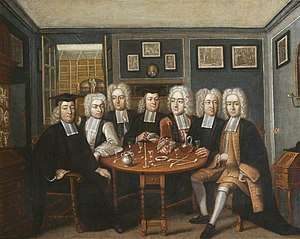Thomas Cockman
Revd Dr Thomas Cockman, Doctor of Divinity (1675–1745) was an Oxford academic and administrator. He was Master of University College, Oxford.[2][3]

Cockman was an undergraduate at University College, Oxford, matriculated in 1692, then a Fellow of the College during 1701–13, before becoming Master of the College later.[1]
Thomas Cockman was Rector at Chidingstone in Kent, in 1705.[4]
Cockman's mastership at University College was a contested one, with William Dennison, who also served as Master between 1722–29. There were two disputed elections held in 1722. Cockman appealed to the Crown and was declared Master of University College in 1729. The success of Thomas Cockman's appeal involved accepting that King Alfred had founded the College. This myth originated from the late 1380s but it was widely believed by Cockman's time. The ruling at the court hearing meant that the Visitor of University College, who is responsible for resolving such disputes, should be the Crown rather than the University. This event acted as the impetus for the college antiquary, William Smith, to write a history of the college, refuting this medieval myth. This materialised as The Annals of University College (1578), the first scholarly Oxford history.[5] Cockman received this book coldly, dismissing it as "the private opinion of a partial disgusted old man, who was always famous for opposition and confounding thing".[6]
In 2008, University College acquired a painting including Thomas Cockman.[7] The painting had remained in Thomas Cockman's family, but was auctioned at Sotheby's. The picture is presumed to be a celebration of the success of Cockman's appeal to the Crown to be declared Master of University College in 1729. The painting was probably commissioned by his brother, John Cockman, who is also in the picture along with a number of Fellows of University College.[1] It was painted by Benjamin Ferrers.
References
- "Portrait of Thomas and John Cockman and some Fellows of University College". The Portraits. UK: University College, Oxford. Retrieved 9 August 2018.
- "Cockman, Thomas (1675–1745) Master of University College, Oxford, miscellaneous correspondence and papers, GB/NNAF/P139362". UK: The National Archives.
- Darwall-Smith, Robin (2008). A History of University College, Oxford. Oxford University Press. ISBN 978-0-19-928429-0.
- Parishes: Chidingstone. The History and Topographical Survey of the County of Kent. 3. 1797. pp. 210–227.
- Carr, William (1902). University College. University of Oxford College Histories. London: F. E. Robinson & Co. pp. 172-7.
- Darwall-Smith, Robert (2017). "Papers of Thomas Cockman (Master 1722–1745)" (PDF). Univ Online Catalogues. p. 7. Retrieved 4 September 2019.
- "A contentious succession". Univ Newsletter (30). UK: University College, Oxford. Summer 2008. Retrieved 9 August 2018.
| Academic offices | ||
|---|---|---|
| Preceded by Arthur Charlett / William Dennison |
Master of University College, Oxford 1722/1729–1745 |
Succeeded by John Browne |